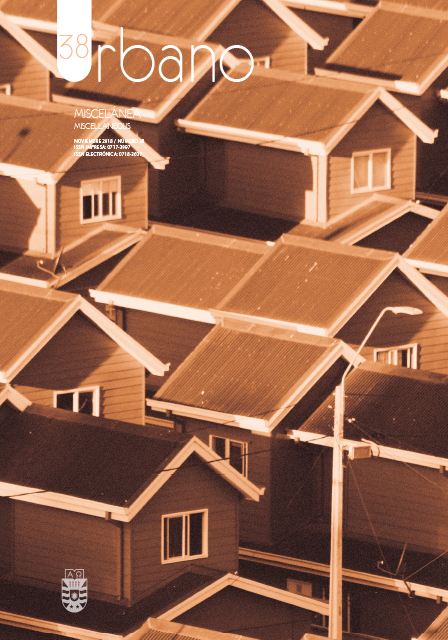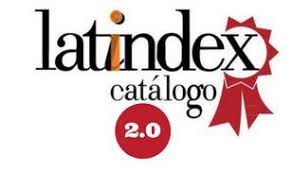The current situation and recent changes in vegetation indices (vis) in forested cities with dry climates. The case of the Mendoza metropolitan area, Argentina
DOI:
https://doi.org/10.22320/07183607.2018.21.38.02Keywords:
variation of vegetation, GIS, remote sensing, urban green infrastructureAbstract
Cities in drylands have adapted to the scarcity of resources and the anthropic-cultural complexity of the habitat. Urban vegetation is a key element for resilience and the mitigation of climate changes when faced with the complex energy-environmental issues related to urban-building morphologies. The objective of this research is to study the current conditions and recent changes in urban vegetation in the 6 municipalities of the Mendoza Metropolitan Area (MMA) by analyzing the temporal and spatial variability of the Normalized Difference Vegetation Index (NDVI) and the Soil-Adjusted Vegetation Index (SAVI). Methodologically, the indices were determined using geographic information systems (GIS) from the analysis of satellite images from Landsat 5 (1986-2011) and Landsat 8 (2013-2017), and a statistical analysis was carried out to estimate trends and correlations. The results obtained indicate a generally decreasing slope in the mean NDVI and SAVI values during the 1986-2011period. The municipalities of Maipú and Guaymallén show the greatest decreasing slopes, and should be given priority for intervention in decision-making to resolve this trend, followed by Luján de Cuyo and Las Heras. Capital is the municipality with the most gradual decreasing slope. During the 2013-2017 period, very high positive correlations were found between municipalities. The municipality of Godoy Cruz is the priority for intervention with the increasing vegetation indices strategy, considering the results by municipality and by urban block for the entirety of the years studied. Lastly, the public green spaces of the MMA that are the priority for intervention are located in Las Heras for the increasing vegetation indices and increasing the surface area of public green spaces strategies.
Downloads
References
BASTIN,Jean-François;BERRAHMOUNI,Nora;GRAINGER,Alan;MANIATIS,Danae; MOLLICONE, Danilo; MOORE, Rebecca; PATRIARCA, Chiara; PICARD, Nicolas; SPARROW, Ben; ABRAHAM, Elena; ALOUI, Kamel; ATESOGLU, Ayhan; ATTORE, Fabio; BASSÜLLÜ, Çağlar; BEY, Adia; GARZUGLIA, Monica; GARCÍA- MONTERO, Luis G.; GROOT, Nikée; GUERIN, Greg; LAESTADIUS, Lars; LOWE, Andrew J.; MAMANE, Bako; MARCHI, Giulio; PATTERSON, Paul; REZENDE, Marcelo; RICCI, Stefano; SALCEDO, Ignacio; SANCHEZ-PAUS DIAZ, Alfonso; STOLLE, Fred; SURAPPAEVA, Venera y CASTRO, Rene. The extent of forest in dryland biomes. Science, 2017, vol. 356, no 6338, pp. 635–638.
CHUVIECO, Emilio. Teledetección ambiental: la observación de la Tierra desde el espacio. Barcelona: Ariel, 2002.
COMISIÓN NACIONAL DE ACTIVIDADES ESPACIALES (CONAE). Índices espectrales derivados de imágenes satelitales Landsat 8 Sensor OLI. Guía de Usuario [en línea]. [Consultado 7 septiembre 2016]. Disponible en: https://catalogos. conae.gov.ar/landsat8/Docs/IndicesEspectralesDerivadosDeLandsat8.pdf.
DAVIS, Amelie; JUNG, Jinha; PIJANOWSKI, Bryan y MINOR, Emily. Combined vegetation volume and “greenness” affect urban air temperatura. Applied Geography, 2016, vol. 71, pp. 106-114.
DIRECCIÓN GENERAL DE CATASTRO [en línea]. [Consultado 1 junio 2010]. Disponible en: https://www.atm.mendoza.gov.ar/portalatm/zoneTop/catastro/ catastro.jsp
EARTH OBSERVATION GROUP (EOG). NOAA NATIONAL GEOPHYSICAL DATA CENTER [en línea]. [Consultado 15 enero 2017]. Disponible en: https://ngdc. noaa.gov/eog/night_sat/nightsat.html
FAN, Chao; MYINT, Soe W.; KAPLAN, Shai; MIDDEL, Ariane; ZHENG, Baojuan; RAHMAN, Atiqur; HUANG, Huei-Ping; BRAZEL, Anthony y BLUMBERG, Dan G. Understanding the impact of urbanization on surface urban heat islands—A longitudinal analysis of the oasis effect in subtropical desert cities. Remote Sensing, 2017, vol. 9, no 7, p. 672.
GANDHI, Meera; PARTHIBAN, S. y THUMMALU, C. Ndvi: Vegetation change detection using remote sensing and gis – A case study of Vellore District. Procedia Computer Science, 2015, vol. 57, pp. 1199–1210.
GÄRTNER, Philipp. European capital greenness evaluation [en línea]. [Consultado 22 agosto 2017]. Disponible en: https://philippgaertner.github.io/2017/10/ european-capital-greenness-evaluation/
GOOGLE MAPS [en línea]. [Consultado 12 noviembre 2016]. Disponible en: https://www.google.com/maps/
HUETE, Alfredo y LIU, Hongqing. An error and sensitivity analysis of the atmospheric- and soil-correcting variants of the NDVI for the MODIS-EOS. IEEE Transactions on Geoscience and Remote Sensing, 1994, vol. 32, pp. 897-905.
HUETE, Alfredo; JACKSON, Ray y POST, Donald. Spectral response of a plant canopy with different soil backgrounds. Remote Sensing of Environment, 1985, vol. 17, pp. 37-53.
INSTITUTO GEOGRÁFICO NACIONAL DE LA REPÚBLICA ARGENTINA (IGM) [en línea]. [Consultado 23 enero 2017]. Disponible en: http://www.ign.gob.ar/
INTERGOVERNMENTAL PANEL ON CLIMATE CHANGE (IPCC). Climate Change 2007: Synthesis Report. Contribution of Working Groups I, II and III to the Fourth Assessment Report of the Intergovernmental Panel on Climate Change. Ginebra: IPCC, 2008.
KASPERSEN, Per Skougaard; FENSHOLT, Rasmus y DREWS, Martin. Using Landsat vegetation indices to estimate impervious surface fractions for European Cities. Remote Sensing, 2015, vol. 7, pp. 8224-8249.
KYBA, Christopher; KUESTER, Theres; SÁNCHEZ DE MIGUEL, Alejandro; BAUGH, Kimberly; JECHOW, Andreas, HÖLKER, Franz, BENNIE, Jonathan, ELVIDGE, Christopher; GASTON, Kevin y GUANTER, Luis. Artificially lit surface of Earth at night increasing in radiance and extent. Science Advances, 2017, vol. 3, n° 11, p. e1701528.
LANDSAT SCIENSE [en línea]. [Consultado 14 noviembre 2016]. Disponible en:https://landsat.gsfc.nasa.gov.
LIGHTPOLLUTIONMAP [en línea]. [Consultado 14 noviembre 2016]. Disponible en: https://www.lightpollutionmap.info/
MCPHERSON, E. Gregory; XIAOB, Qingfu; VAN DOORNC, Natalie S.; DE GOEDED, John; BJORKMAND, Jacquelyn; HOLLANDERD, Allan; BOYNTOND, Ryan; QUINND, James y THORNE, James. The structure, function and value of urban forests in California communities. Urban Forestry & Urban Greening, 2017, vol. 28, pp. 43–53.
MILES, Lera; NEWTON, Adrian; DEFRIES, Ruth; RAVILIOUS, Corinna; MAY, Ian; BLYTH, Simon; KAPOS, Valerie y GORDON, James. A global overview of the conservation status of tropical dry forests. Journal of Biogeography, 2006, vol. 33, pp. 491-505.
MONTEITH, John. Principles of Environmental Physics. Londres: Edward Arnold, 1973.
MORÁN, M. Susan; JACKSON, Ray; SLATER, Philip y TEILLET, Philippe. Evaluation of simplied procedures for retrieval of land surface reflectance factors from satellite sensor output. Remote Sensing of Environment, 1992, vol. 41, pp. 169-184.
MUNICIPALIDAD DE CAPITAL [en línea]. [Consultado 4 noviembre 2010]. Disponible en: http://www.ciudaddemendoza.gov.ar
PEARLMUTTER, David; BITAN, Arieh y BERLINER, Pedro. Microclimatic analysis of “compact” urban canyons in arid zone. Atmospheric Environment, 1999, vol. 33, pp. 4143-4150.
RAMSEY R. Douglas; FALCONER, Allan y JENSEN, John Robert. The relationship between NOAAAVHRR NDVI and ecoregions in Utah. Remote Sensing of Environment, 1995, vol. 53, pp.188-198.
ROUSE, John; HAAS, R.; DEERING, D., SCHELL, J. y HARLAN, J. Monitoring the vernal advancement and retrogradation (Green wave effect) of natural vegetation, Final Report. Texas: A & M Universiy, 1974.
RUIZ DURÁN, M. Eva; OROZCO HERNÁNDEZ, M. Estela; GRANADOS RAMÍREZ, Rebeca y ÁLVAREZ ARTEAGA, Gustavo. Cambio de uso de suelo e índice de vegetación de diferencia normalizada (NDVI), Subcuenca del río Salado, México. Geografía y Sistemas de Información Geográfica, 2017, vol. 9, pp.39-50.
SALINAS-ZAVALA, César; MARTÍNEZ-RINCÓN, Raúl y MORALES-ZÁRATE, M. Verónica. Tendencia en el siglo XXI del Índice de Diferencias Normalizadas de Vegetación (NDVI) en la parte sur de la península de Baja California. Investigaciones Geográficas, 2017, vol. 94.
SANTAMOURIS, Mattheos; HADDAD, Shamila; SALIARI, Maria; VASILAKOPOULOU, Konstantina; SYNNEFA, Afroditi; PAOLINI, Riccardo; ULPIANI, Giulia; GARSHHASBI, Samira y FIORITO, Francesco. On the energy impact of urban heat island in Sydney. Climate and energy potential of mitigation technologies. Energy and Buildings, 2018, vol. 166, pp. 154-164.
SANTANA-RODRÍGUEZ, Luis; ESCOBAR-JARAMILLO, Luis y CAPOTE, Paolo. Estimación de un índice de calidad ambiental urbano, a partir de imágenes de satélite. Revista de Geografía Norte Grande, 2010, vol. 45, pp. 77-95.
SHAHABI, Himan; AHMAD, Baharin; MOKHTARI, Mohammad y ZADEH, Mohsen. Detection of urban irregular development and green space destruction using normalized difference vegetation index (NDVI), principal component analysis (PCA) and post classification methods: A case study of Saqqez city. International Journal of the Physical Sciences, 2012, vol. 7, pp. 2587-2595.
UNITED STATES GEOLOGICAL SURVEY (USGS), EARTHEXPLORER [en línea]. [Consultado 20 septiembre 2016]. Disponible en: https://earthexplorer.usgs. gov/
VIRGINIA, Ross y WALL, Diana. Ecosystem function, Principles of. Encyclopedia of Biodiversity, 2001, vol. 2, pp. 345–352.
ZHANG, Hankui y ROY, David. Landsat 5 Thematic Mapper reflectance and NDVI 27-year time series inconsistencies due to satellite orbit change. Remote Sensing of Environment, 2016, vol. 186, pp. 217–233.
Published
How to Cite
Issue
Section
License
The content of articles which are published in each edition of Habitat Sustentable, is the exclusive responsibility of the author(s) and does not necessarily represent the thinking or compromise the opinion of University of the Bio-Bio.
The author(s) conserve their copyright and guarantee to the journal, the right of first publication of their work. This will simultaneously be subject to the Creative Commons Recognition License CC BY-SA, which allows others to share-copy, transform or create new materials from this work for non-commercial purposes, as long as they recognize authorship and the first publication in this journal, and its new creations are under a license with the same terms.![]()























